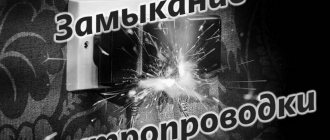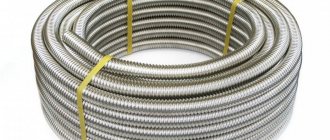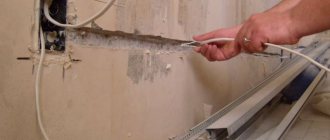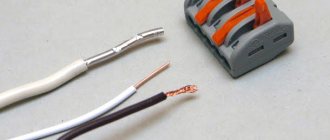Transition resistances
Transitional
are called
resistances
in places where current passes from one contact surface to another through the areas of their actual contact
.
In such a contact connection, a certain amount of heat is released per unit time, proportional to the square of the current and the resistance of the areas of actual contact.
The amount of heat generated can be so significant that the transition resistances become very hot. Consequently, if heated contacts come into contact with flammable materials, they may ignite, and contact of these places with explosive concentrations of flammable dust, gases and vapors of flammable liquids will cause an explosion.
To increase the areas of actual contact between the contacts, it is necessary to increase their compression forces by using elastic contacts or special steel springs.
To remove heat from points of contact and dissipate it into the environment, contacts with sufficient mass and cooling surface are required.
Thus, to ensure safe working conditions in existing electrical installations
a set of measures should be provided that are implemented at all stages - before the start, during the implementation and at the completion of the work. Activities mean the organization of certain actions in electrical installations (registration of work, appointment of those responsible, preparation of the work site, conducting briefings, etc.), as well as specific manipulations with electrical installation devices (switching, checking the presence or absence of extinguishing in live parts, installation of protective grounding and others). In addition, it is worth taking into account local conditions and applications of electrical installations.
Considered causes of fires
are relevant. Today, a person cannot do without machines, installations and computers. Every year, as practice shows, the use of electrical installations is increasing, and the sooner measures to prevent fires are developed and taken, the safer the future awaits us.
Fire conditions and stages
For a fire to occur, three conditions must be present:
- Combustible substances and materials
- Ignition source - open fire, chemical reaction, electric current.
- The presence of an oxidizing agent, such as atmospheric oxygen.
The essence of combustion is the following: heating the ignition sources of a combustible material before its thermal decomposition begins. The process of thermal decomposition produces carbon monoxide, water and a large amount of heat. Carbon dioxide and soot are also released, which settles on the surrounding terrain. The time from the start of ignition of a flammable material to its ignition is called the ignition time.
The maximum ignition time can be several months.
From the moment of ignition, a fire begins.
Depending on the magnitude of the fire load, its placement over the area and the parameters of the room, the type of fire is determined:
- local;
- volumetric, adjustable fire load;
- volumetric, adjustable ventilation.
Curves of changes in average volume temperature during a fire depending on the type of fire load
- During the first 10-20 minutes, the fire spreads linearly along the combustible material. At this time, the room is filled with smoke, and it is impossible to see the flames. The air temperature in the room gradually rises to 250-300 degrees. This is the ignition temperature of all flammable materials.
- After 20 minutes, the volumetric spread of the fire begins.
- After another 10 minutes, the glazing begins to fail. The influx of fresh air increases, and the development of fire increases sharply. The temperature reaches 900 degrees.
- Burnout phase. Within 10 minutes maximum fire speed.
- After the main substances burn out, the fire stabilization phase occurs (from 20 minutes to 5 hours). If the fire cannot spread to other rooms, the fire goes outside. At this time, the collapse of burnt out structures occurs.
Fire protection measures
Various protective measures should be taken to keep the wiring in good condition, for example, laying it under plaster rather than under flammable building materials. As for shields, it is better to choose them from metal or non-flammable plastic - this will serve as protection against the spread of fire. We described in detail how to choose an electrical panel in a separate article.
It is also important to inspect the electrical wiring at least once a year: look at all wire connections in sockets, switches, junction boxes and in the electrical panel itself. Timely detection of poor contact and melted wires is one of the effective ways to protect against fire
If the wiring is old, be sure to replace it with a new one during the next repair. Cracked insulation, old sockets designed for a lower current load, plugs in the panel. All this can lead to a fire at any moment. If it is not yet possible to spend money on replacing the wiring in the apartment, be sure to install automatic circuit breakers and RCDs in the panel. They will save you from a fire at the right time. It is also advisable to install a 100 or 300 mA fire protection RCD at the input in wooden houses as an additional measure of protection.
The fire protection RCD is described in detail in the video:
In addition to all this, it is important to know and under no circumstances repeat typical mistakes when installing electrical wiring, which we wrote about separately. For example, poorly made twisting can cause a short circuit and further fire in the electrical wiring.
Therefore, there is no need to do twists at all.
And of course, if the apartment smells of burnt wiring, and you yourself are not able to find and fix the problem, be sure to call an electrician, having first turned off the circuit breakers in the panel.
What to do in case of a wiring fire?
If the apartment smells of burnt wiring, you notice smoke or an open fire in places where wires run or connect, or on electrical appliances that are turned on, you must take the following measures:
- Turn off the electricity, preferably at the input circuit breaker, in order to ensure a simultaneous break in both phase and zero. Without this, there is a high probability of electric shock in case of fire.
- If possible, protect the source of the fire or localize the fire. Under no circumstances should you touch hot elements to prevent burns.
- If there is a fire, begin to extinguish it.
If for some reason the operating conditions of the electrical wiring do not allow it to be de-energized, then the wiring must be extinguished using special means that do not conduct electric current.
Protection measures
It is much easier to prevent a wiring fire in an apartment than to try to recover from the consequences of a fire. Therefore, to prevent wiring fires, certain safety precautions should be observed:
- At the stage of installation or replacement of electrical wiring, it is necessary to provide a margin for the cable cross-section. This will allow you to increase power if you connect any new device without the risk of fire.
- Ensure that wires are insulated from flammable materials using non-flammable gaskets. For example, on wooden walls it is important to use a special corrugated pipe, textolite strip, asbestos plates and other non-combustible materials. A metal strip can only be used if it is grounded through an RCD, since in the event of a fire in the wiring, potential will transfer to the metal.
- When replacing wiring, you should use a copper cable specifically designed for domestic premises. Despite its high cost compared to aluminum wiring, it is much more reliable. And modern insulating materials do not support combustion, which makes it impossible for such wiring to catch fire.
- Do not connect wires inside walls. Such components cannot be detected until a fire occurs. Therefore, all conductors from the box to the consumer, switch or socket must be solid. And at the connection points they must be connected with factory clamps, avoiding twists.
- If there is a connection between aluminum and copper conductors in the house, such a point should be fixed using a brass sleeve or a special terminal clamp. Even the use of a brass gasket and tightening with a bolt does not provide a 100% guarantee, since the gasket is destroyed and oxidized over time due to the flow of electric current. Figure 2: Wire Connection
- Do not use shields, cabinets or boxes made of flammable materials. Since in the event of a fire in the same electrical panel, the housing itself will support the combustion. Which will lead to the spread of fire to adjacent elements of the building. If metal distribution panels are used, the fire will not spread beyond its boundaries.
- Use short circuit protection both between cable cores and to ground. It is necessary to select an RCD in such a way that it allows you to de-energize the network in the event of a fault in the wiring or devices, when connecting a load that is too large for wiring, and in other emergency situations. Figure 3: Connecting machines
- Refuse to use faulty devices - if you notice damage to the insulation, unusual noise and other signs, take it for repair. The operation of such devices not only threatens their breakdown, but can also lead to a fire in the wiring.
- When repairing equipment or any elements of the electrical network, turn off the power to the room. Since the cause of a fire is often an artificial short circuit made by a careless repairman during work.
- When leaving home, be sure to turn off the power to each device whose operation is not necessary in your absence. Since the cause of a short circuit and further fire in the wiring can be an unloaded device. And if you are away from the apartment for a long time, it is better to turn off the input machine.
It should be noted that the best way to prevent a fire is a fire alarm. Especially for wooden houses or rooms with flammable finishes. Since it will notify about burning wiring even before the critical spread of the flame. Despite the additional costs, this solution will ensure fire safety for your home.
Conclusion
The causes of electrical fires are associated with faulty condition of electrical wiring, electrical equipment, and its improper operation.
To prevent fire, you should repair electrical wiring, sockets, switches, and use only serviceable devices.
It is prohibited to place the equipment near flammable objects, surfaces, or substances. The premises must have primary fire extinguishing means.
This is interesting: The keys of the pass-through switches are in different positions: let’s understand it thoroughly
Causes of electrical wiring fires
If safety precautions are neglected, a fire may occur in the premises. Electric shock can also lead to serious consequences. We will look at the most popular causes of wiring fire below.
Technical difficulites . It is important to monitor the condition of all network wiring as well as their connections. This includes the main and distribution board, because it is in such places that the main cable routes are supplied, and various protective devices are installed. All devices must be in working order. Backup protection should be installed in the switchboards in advance, which can be used in the event of some dangerous situation (for example, short circuit protection). Basically, a fire in electrical wiring is possible due to poor contact, so you should pay special attention to the electrical wiring connections. For safety and reliability during operation, it is necessary to install protective shutdown devices in an apartment, in production or in workshops, especially where there is high humidity.
Moving smoothly from one reason to another, it should be noted that often a fire in the wiring in an apartment occurs due to the fact that the circuit breakers are incorrectly selected . The fact is that the purpose of the machine in the panel is to instantly operate in the event of a short circuit or overload in the network. So, with regard to overload, when choosing a circuit breaker, you need to pay attention to the fact that the rating of the circuit breaker corresponds to the cross-section of the wiring for which it is installed to protect. Otherwise, if there is an overload, the cable in the wall will begin to melt and may catch fire, and the machine will not work, or will work only when a short circuit occurs, which may be too late and will still lead to a fire in the house or apartment.
Improper or unsafe operation . Each device has a permissible load limit. The cause of the fire may be the connection of different splitters or extension cords into one outlet. Damaged plugs or cords from appliances pose a great danger. If, a short time after turning on an electrical appliance, the plug or splitter gets hot, this means that there is a problem in the contact connections.
Lighting group malfunction . Over time, lighting devices become the cause of fires. For example, it is necessary to protect an incandescent lamp from splashes, and a switch from moisture.
Technical faults include connecting an aluminum wire to a copper wire . Even if everything is connected correctly and the neutral wires are connected with a special strip, an electrical fire may occur. A strip made of brass material is not suitable for such connections, because over time it oxidizes and the aluminum and brass heat up, which consequently leads to a fire. If such a connection was inside a shield made of flammable plastic, then the consequences will be even worse, because instead of preventing combustion, it begins to melt and support the fire. It is possible to connect aluminum with copper if there is no other way to do the electrical installation. However, the connection must be made either through special WAGO terminal blocks or using special sleeves.
Another reason is poor quality and old sockets . After all, the plug of the electrical appliance itself must fit tightly into the socket. If the plug gets hot or sparks, replace the socket immediately. It's better to pay a little more, but buy a quality outlet. Although they may look the same, in cheap models the plastic heats up and catches fire, and the contacts do not have compression springs. We talked about how to choose sockets and switches in a separate article.
The next reason is old aluminum wiring . In old multi-storey buildings, distribution boards are located on the staircase. They are often in very poor condition, so there is a particular risk of fire. Also, in most old houses, the electrical wiring has never been changed, which means that it has already outlived its usefulness, the insulation becomes unusable, and, accordingly, does not protect against a short circuit in the wall. To this we can add that now they use much more electrical appliances than before, so the load increases on old wires, which can be aluminum and withstand small loads.
Today there is a problem of low-quality electrical goods . These products cannot withstand the load declared by the manufacturer. It is often necessary to troubleshoot problems in a house or apartment where the wiring has only recently been changed. After about a couple of years, the cable insulation cracks and begins to crumble, and this inevitably leads to a fire.
Some of the causes of wiring fires are clearly shown in the video:
Main reasons
An electrical fire can occur in the following situations:
- Short circuit. In this case, the temperature in the damaged area increases several times, melting the electrical wiring strands. Occurs due to breakdown of the insulating material (mechanical damage, microcracks, increased voltage, old electrical wiring).
- Network overload current. It is typical when connecting electrical equipment of increased power, the appearance of large leakage currents, and an increase in temperature in certain areas. These reasons also lead to overheating and subsequent fire.
- Often electrical wiring burns at the junction of current-carrying conductors. As a result of weakening or oxidation of the contact, the contact resistance of the electrical wiring sharply increases, which entails overheating and subsequent fire.
The most common cause of electrical fire is a faulty or damaged power cord for electrical appliances. If this happens, the first thing you need to do is disconnect the device from the mains, cover the fire area with a rag and put out the fire. Most apartments have flower pots, the soil from which is perfect for putting out flames.
This is interesting: What kind of introductory machines should there be after replacing the riser
Sudden load fluctuations
A large number of modern instruments and devices, constantly connected to the network and operating in a certain mode, sometimes cause a significant increase in load. They usually don't last long, but at some point they can become critical. Why is this happening?
Modern electrical appliances are much more economical than old household appliances; almost all of them are class A or even A+. But there is one feature - there are many of them and some of them work automatically. They either connect and consume energy, then go into sleep mode and take the minimum from the network. There is a TV in one room, a computer in another, an economical refrigerator hums quietly in the corner, an energy-efficient dryer dries mushrooms, a modern low-consumption air conditioner cools the air, a washing machine does the laundry, and then an A+ class electric boiler started heating the water and the multicooker turned on at a high temperature. your program. At some point, the load may become critical for the home's electrical network.
Elimination of short circuit consequences
If the search for the short circuit was successful, then it’s time to exhale and start eliminating it. What to do next depends on the extent of the damage to the electrical wiring. Regardless of the situation, before starting any repair work, you should definitely turn off the power to the apartment and make sure there is no voltage.
It is necessary to assess how much the cable insulation was damaged at the time of the short circuit. If there are swelling, darkening or melting, the wire must be replaced. If possible, it is necessary to assess its condition along its entire length.
Connecting wires in the distribution box using terminal blocks
If the wire covering is in order, then the immediate location of the short circuit is removed. The surviving ends of the current-carrying conductors are stripped and connected using Wago terminal blocks, welding, soldering or crimping. In low-current circuits, you can use regular fast twisting at your own risk. However, the PUE (7th edition, clause 2.1.21) does not provide for and does not approve of this method of connecting cables.
Why does an LED spotlight glow when the switch is off?
Why do half the LEDs on the floodlight glow when the switch is off?
Perhaps the neutral wire passes through the switch, while the phase wire is connected directly to the lamp. if the body of the lamp (provided that the insulation in the lamp itself is damaged) or the core passing through the switch (zero) after the switch is in contact with the ground somewhere, the lamp may well burn “at full intensity”. the same effect with a faulty switch - it seems to break the wire, but not completely, it breaks through. As a result, there is a small volt on the lamp, say, 100 - 150. If this is the reason, you need to swap the power wires not at the lamp, but up to the switch.
I personally bet on an insulation breakdown in the lamp itself (the ground goes to the lamps through the body) plus the phase directly, past the switch. check. if the switch breaks zero, swap the wires coming from the panel.
Most likely, if the spotlight is receptacled, then it is either without grounding, or if it is homemade, Chinese, then on the contrary, with grounding. If it is built into a switch without wires, then the switch may have a built-in backlight LED that should be removed and the lighting will stop. It is possible that the path to the LED has burned out and shorted out. It’s hard to say anything without at least a photograph or a more accurate description of the problem.
there are two options! 1st: LED in the switch!
2nd: double switch! (confusion in electrical phase, zero)
In the beginning, you just need to test the spotlight on the table, directly connecting it to the network. Check with a tester whether there is voltage on the body of the spotlight (zero body). If there is no leak, replace the old switch, checking all wiring.
You connected it incorrectly. The switch must break the phase, your zero breaks. This also happens with LED lamps, energy-saving lamps, and fluorescent lamps.
I will answer your question from a technical point of view. Any modern electric boiler from a well-known manufacturer is distinguished by high quality and reliability. The choice can only be based on the design of the device and, of course, the price.
A question of economy. The answer may be this: very approximately, heating ten square meters will require one kilowatt of electricity.
Everything else depends on the heat losses of the house, the quality of the walls, windows, and so on. We need a very competent design of the heating system itself, taking into account all the nuances and subtleties of the structure and electrical wiring capabilities. Only after the project can you begin to select the boiler itself. I cannot give specific advice in recommendations, since I do not know the offer in your region. Let me return to the advice, it is better to choose a well-known manufacturer.
I am not an energy specialist or a theoretical physicist, but my personal opinion is that if there is energy, then it can be converted into electricity, if you have the necessary converters and devices for this. Of course, in our time it is not yet possible to create everything, something simply has not been invented yet, but is already at the stage, something is not yet allowed by our development, something is possible in general humanity will never be able to implement, but theoretically it’s all possible! And leading scientists have spoken about this more than once in their interviews with various media.
What to do if the wiring in the apartment catches fire?
Electricity makes human life more comfortable and convenient. At the same time, it is a source of increased danger, causing more than half of the fires occurring in the country.
As a result, people die, expensive property is destroyed, and residential buildings and commercial structures become unusable. When purchasing real estate, its owners cannot know about the condition of the wiring installed in it and the purchased household appliances.
Knowing what to do if the wiring catches fire, you can quickly and without serious consequences avoid an emergency situation.
How not to extinguish live wiring
Fired wiring cannot be extinguished with water or any liquids based on it.
If the wiring in an apartment catches fire, you need to make the right decision regarding the choice of means to extinguish the flame. Rash actions can only aggravate an already difficult situation.
The use of the following means to extinguish live wiring is strictly contraindicated:
- Water and any solutions based on it. Such liquids are excellent conductors of electricity. You can get an electric shock immediately when pouring water. Then the situation only becomes more complicated, as the liquid spreads across the floors, turning the apartment into a high-risk zone.
- Factory-made and home-made alcoholic drinks. When heated, they catch fire, a pungent odor can cause poisoning, and carbon dioxide can cause loss of consciousness.
- Food products (vinegar, sauces, broths). Firstly, they contain water. Secondly, when they are heated, preservatives are released into the air, creating steam and smoke, which impairs visibility.
- Synthetic fabrics. When exposed to fire, they melt, burst into flames, and emit large amounts of toxic smoke. Such materials can ignite surrounding objects with a low ignition temperature.
The best means of fighting fire (in the absence of fire extinguishers) are products made of leather, fur and thick tarpaulin. These materials are non-flammable and airtight, which is the main condition for fighting fire. If the wiring burned out, but everything else survived, damaged clothes are a trifle.
What to do if you can’t put out the fire
If a fire occurs, all doors and windows must be tightly closed to prevent the fire from spreading.
Apartments filled with wooden and plastic products can burn down in a matter of minutes. But the main danger to human life is not fire, but smoke. This must be taken into account when deciding on the course of action in a critical situation.
If the fire cannot be extinguished, the following measures are recommended:
- Close all windows and interior doors tightly and leave the home, taking your phone, documents and valuables with you. In an enclosed space, the fire moves slowly. There is a chance that it will not catch fire before firefighters arrive.
- If the front door is blocked by fire or smoke, lock yourself in the bathroom. After this, wet the towels and plug the cracks with them. Then water the door leaf to prevent it from igniting and burning through.
- When there is a blockage in the back room, you need to use the window to breathe, call for help or go to the fire escape, which will be a great success.
If all of the above methods turn out to be unavailable, you need to lie on the floor by the window, breathe through natural fabric and wait for salvation. You should not try to break through the fire and smoke to the exit. The heat and poisonous gases can cause you to instantly lose consciousness and burn alive.
Kaliningrad resident will receive compensation for equipment and wiring burned down due to the fault of the management company
Kaliningrad resident Galina Beteneva, the owner of an apartment in the village of Pribrezhny, sued the management company for poor-quality wiring repairs, which almost caused a fire in the entire house. All of Galina’s household appliances burned down. Compensation for damage had to be sought through the courts.
According to Beteneva, on June 6, 2012, the manager’s electricians were repairing the wiring in one of the apartments in the high-rise building. In the evening of the same day, the wires began to smoke in another apartment, and closer to night there was a sharp voltage drop in the house. Working equipment, electrical appliances and light bulbs began to smoke. Galina Nikolaevna’s property suffered the most: the TV, subwoofer, receiver, DVD player, adapters from the telephone, desk clock, subwoofer power supply, and light bulbs burned out.
“There was a lot of smoke. While we opened the windows and figured out what was happening, everything burned down. Even the surge protectors didn’t work,” Galina Beteneva told a Klops.Ru correspondent.
Residents of neighboring apartments called emergency services. The workers carried out an inspection and concluded that the “zero” wire had broken.
“This is a common wire through which electricity is supplied to all consumers. It broke and the voltage increased: instead of 220 volts, all 380 volts went into the apartments,” explained Galina’s husband Evgeniy Minichev, an electrician by training. “If the insulation caught fire, there could be a fire.”
The service workers were unable to turn off the current and fix the problems, since the keys to the main distribution board were in the possession of the electricians of the management company. Residents were instructed to turn off power in their apartments themselves, which allowed them to avoid more serious consequences.
The management company fixed the problems only a day later.
After some time, Galina Nikolaevna went to UKBR-5 with a written complaint and a list of burnt equipment. There they told her: “Do the repairs, do the examination, and then we will pay you.”
The equipment was repaired at the service center, and they also provided an opinion on the cause of the breakdown. After this, Galina Beteneva again submitted a statement to the management company’s office, enclosing receipts for repairs and examination, but received a written refusal to compensate for the damage.
I had to go to court to enforce the obligations. “It was possible to demand compensation for material and moral damage. Such cases are regulated by the law “On the Protection of Consumer Rights,” explained Galina Beteneva. “We also collected all the witnesses to what happened; my husband and residents of other apartments gave testimony. In addition, they provided a document on ownership. And if the apartment is municipal, you need to present an apartment card and a copy of your personal account,” said Galina Nikolaevna.
The court ordered the management company to pay the family 10 thousand rubles as compensation for material damage and 5 thousand rubles for moral damage. The plaintiff was also compensated for the costs of the examination and the lawyer.
What do the experts say?
As Marina Buchnaya, press secretary of the Kaliningrad Regional Court, told Klops.Ru, in its actions the management company must adhere to the “Rules for the maintenance of common property in an apartment building”, approved by Decree of the Government of the Russian Federation No. 491 of August 13, 2006. According to paragraph 10 of these rules, common property must be kept in a reliable and safe condition.
Art. 29 of the Law “On Protection of Consumer Rights” provides for compensation for losses to the consumer. And in Art. 1064 of the Civil Code of the Russian Federation, a person responsible for causing harm to a person or property is obliged to compensate for the harm in full, unless he proves that the harm was caused through no fault of his own.
“Citizens often go to court to restore their rights, demanding compensation for material damage,” added Marina Buchnaya. — At present, the decision of the Leningradsky District Court, which last year collected about 56,000 rubles from LLC "UK Leningradsky District" in favor of the tenant, has been executed. As a result of a power surge in the man's apartment, almost all household appliances failed: electric oven, freezer, home theater, monitor, printer, copy machine, scanner, fax, game console, computer system unit, router. A similar case will be considered by the Svetlogorsk City Court the other day. In the lawsuit, the tenant indicated that due to problems with the electrical wiring of the house in the village of Yantarny, household appliances and equipment were destroyed and damaged. Currently, the claim has been accepted for proceedings, and a preliminary hearing has been scheduled.”
Actions in case of electrical fire
Electricity is an integral part of every person’s life, which makes life easier and more comfortable. However, if certain rules for using electricity are not followed or working with faulty electrical appliances can lead to property damage or pose a threat to human life and health. For example, many people live in houses that were built several decades ago, and the electrical wiring of the premises remains from those times. Of course, the condition of such electrical wiring leaves much to be desired, and if the wires are not replaced in time, a fire may occur, which in the worst case may develop into a fire.
How can you extinguish live wiring?
It happens that when an electrical wiring catches fire, there is no person nearby and it is impossible to quickly put out the flames. In these cases, in order to prevent a fire, it is necessary to act quickly and it is not always possible to run to the electrical panel to turn off the power to the house. A fire in its initial stages can be extinguished using earth and sand. But for such emergencies, it is better to have a special fire extinguisher in the house. Not all types of this device can be used to extinguish live appliances and electrical wiring. Therefore, before purchasing, you need to figure out which fire extinguisher can extinguish electrical wiring.
The best option is a carbon dioxide fire extinguisher, which can be used to extinguish fires in electrical installations under voltage up to 10,000 V. The extinguishing agent has a low temperature and is supplied under high pressure. Due to this, it is possible not only to eliminate the fire, but also to cool the smoldering sections of the electrical wiring. The main disadvantage of this device is that the vapors released during evaporation are harmful to human health. Therefore, it is prohibited to use a carbon dioxide fire extinguisher to extinguish fires in unventilated areas.
For apartments and private houses where the network voltage does not exceed 380 V, a good option would be to purchase a powder fire extinguisher, which can be used to extinguish electrical installations under voltage up to 1000 V. The powder agent quickly eliminates the fire by isolating the source of the flame from oxygen.
If it is possible to turn off the power, you can use water and foam fire extinguishers. Otherwise, you cannot extinguish electrical wiring with such means, because a person can be electrocuted. When extinguishing a fire, a distance of 1 meter must be maintained.
Prevention measures
If the electrical installation rules were followed when installing electrical wiring, then proper handling of electrical appliances minimizes the risk of wire fires. However, you cannot be 100% sure on this issue, and to prevent possible problems it is better to follow the recommendations described below.
You cannot use many tees and extension cords; it is advisable to lay the cord from them along the walls so that people do not step on it or heavy objects are placed on it. You need to know that the maximum current for a single-phase socket is 16 A. If this threshold is exceeded, the current protection may not work and the socket will become dangerous.
It is necessary to inspect junction boxes several times a year. The contacts are checked for the strength of the connection, and the oxidation layer, if one has formed, is cleaned.
It is necessary to monitor the condition of the sockets and periodically check the reliability of the clamping contacts. Worn-out products may begin to spark, which can subsequently cause a fire and develop into a fire.
Heating electrical appliances that are turned on must be constantly monitored. If you need to leave the house for a long time, you can turn off the electricity supply at the electrical panel.
Short Circuit Detection Techniques
If the circuit breaker has tripped, then the worst has been avoided. Then the question arises of how to find a short circuit in the apartment wiring. There is no need to panic. There is a chance that you will be able to detect the malfunction yourself without calling a specialist. Finding a short circuit in an apartment is divided into four simple steps:
- Visual inspection.
- Elimination method.
- Detection by sound and smell.
- Use of special measuring instruments.
Visual inspection
It is not a fact that the short circuit point is in the wall. Usually the fault lies on the surface. It can be seen with the naked eye and quickly eliminated.
Extension cords need to be inspected. Especially in places where the cable bends and the plug is connected. Often one wire comes loose and dangles in the air. A phase contact that is not secured by anything can touch the neutral contact and lead to a short circuit. Next are the sockets. Wires can also fall off and end up in the wrong place.
Visual inspection of electrical wiring in a private house
Elimination method
If a simple inspection does not help, you will have to move on to the elimination method. The main thing is to understand why the machine is triggered. It is worth remembering under what circumstances the short circuit occurred. If the embarrassment occurred at the moment when the iron was plugged into the socket, then the problem lies there. If not, you should turn off the household appliances one by one until the circuit breaker stops tripping.
If absolutely all devices are unplugged and the lights are turned off everywhere, then you will have to move on to the next stage. It is important to remember to check devices that are always plugged in (refrigerators, televisions).
Additional Information. You will never find a short circuit that is not there. Old circuit breakers are prone to false trips. That is, there is no short circuit in the wiring, and the machine lives its own life and turns off the apartment for no known reason. Before searching for a short circuit, it would not hurt to make sure that the protection devices are operating adequately and find out for sure why the circuit breaker trips.
Sound and smell detection
When a short circuit occurs, a lot of energy is released. She doesn't leave without a trace. Often in the problem area the wires heat up, the insulation melts, smoke is formed and there is a smell of burning. If the circuit is unstable, then when voltage is applied at the short circuit point, a bright flash with sparks and a bang will occur. Its intensity is such that it is almost impossible not to notice this phenomenon even in hidden wiring.
This and the previous methods require periodic re-switching of the voltage. This, in turn, will lead to a short circuit again. It is advisable to carry out such experiments a minimum number of times and with at least some knowledge and experience of such work. If possible, it is wiser to call a professional electrician. He will most likely come with a multimeter or megger.
Use of special measuring instruments
The method requires electrical engineering education. The closure point is sought using measuring instruments:
- multimeter;
- megohmmeter;
- indicator screwdriver;
Checking electrical wiring using a multimeter
These devices allow you to ring the apartment's electrical network and determine in which area there is a point with an abnormally low resistance between the phase and neutral (ground) conductors. The most effective way to find short circuits is a megohmmeter. But it is much safer to use a multimeter in diode testing mode. If a section of wiring with a short circuit is connected to its terminals, the device beeps.
Overloads as an emergency mode of operation of electrical equipment
Overload
This is called
an emergency mode
in which currents arise in the conductors of electrical networks, machines and devices that for a long time exceed the values allowed by the standards.
One of the types of transformation of electrical energy is its conversion into heat. Electric current in the conductors of electrical networks, machines and devices releases heat, which is dissipated in the surrounding space. Conductors can reach dangerous temperatures. Thus, for bare copper, aluminum and steel wires of overhead lines, the maximum permissible temperature should not exceed 70°C. This is explained by the fact that with increasing temperature, oxidative processes intensify and oxides with high resistance are formed on the wires (especially in contact connections); The contact resistance increases, and, consequently, the heat generated in it. As the connection temperature increases, oxidation increases, and this can lead to complete destruction of the wire contact.
The cause of
overload may be caused by incorrect calculation of conductors during design. If the cross-section of the conductors is underestimated, then when all the provided electrical receivers are turned on, an overload occurs. Overload may occur due to the additional inclusion of electrical receivers for which the network conductors are not designed.
To avoid overload or its consequences, during design it is necessary to correctly select the cross-sections of network conductors according to the permissible current, as well as electric motors and control devices.
During the operation of electrical networks, you cannot turn on additional electrical receivers if the network is not designed for this.
Features of LED lamps
Someone immediately begins to think about the presence of a bad contact or some kind of problem with the chandelier. In fact, the reason lies in somewhat different circumstances. It should be sought in the design features of the lamp itself.
Energy saving lights or LEDs operate at 12 volts even though they are connected to 220 volts AC power. The voltage conversion process is carried out directly in the base part of the light device itself. It contains a diode bridge and a capacitor. Such a construction can be represented as follows:
Connecting lighting based on LED or neon bulbs has its own characteristics
Even if you remove the load on the supply circuit, microcurrents continue to exist in a certain amount. There are very few of them, but this is quite enough for the capacitor to accumulate a certain charging value.
It will be enough to “start” the lamp. The light source will be lit. But there is too little of it to supply enough power for the glow. Therefore, the glow quickly stops. The light source will attempt to “ignite” until the capacitor is discharged. When observing a similar phenomenon, they say that the lamp “blinks.”
There are cases where, after being turned off, the lamp begins to glow dimly. This effect is explained by the presence of insufficient resistance in the filament circuit. Such a circumstance will lead to a situation in which only a small amount is supported when charging the capacitor element.
What to do if there is a wiring fire
Statistics show that people often do not know the rules of conduct when an electrical cable burns. The algorithm of actions in such a situation is as follows:
- De-energize the room. It is advisable to turn off the input machine.
- Put out the fire. If necessary, you can call a neighbor for help.
- When localizing the fire, do not touch surfaces. They're hot.
- The fire extinguishing agents used must not conduct current.
- If you realize that you cannot control the fire, call the fire department.
First actions
The causes of electrical panel fires in the entrances of microdistricts are often unknown. Despite this, the liquidation procedure has the following sequence:
- Do not panic. Do everything quickly, but calmly.
- Unscrew the plugs or turn off the machine.
- Evacuate women and children.
- Call the fire department.
- Eliminate the air supply. Close the windows and doors.
- Wet a towel and cover your nose with it.
- Find the source of the fire. Use available means to eliminate it (blanket, soil from flowerpots).
- If there is a great risk to your life, leave the premises. Wait for the rescuers. They will localize the fire and find out who is to blame.
- After extinguishing the fire, call an insurance representative and demand payment of compensation.
How to stew
Localizing a wiring fire can be done in four ways:
- Turn off the power to the burning network and use available means.
- Use fire extinguishers that correspond to the fire class. This option is more suitable for enterprises.
- Extinguishing non-de-energized wiring can only be done with sand or earth. The use of other improvised means is life-threatening.
- To put out fires in winter, you can use a snowball. A well-aimed hit at the source of fire will short-circuit the wiring and the machine will turn off.
In order to prevent network overload or short circuit, it is necessary to make simple calculations. If the wiring in the electrical panel smells, in order to avoid a fire, you need to take the device and inspect it. There is a video that describes in detail how to do this. If you are not confident in your own abilities, call an electrician.
Hazard Prevention Measures
The first and most effective way is to install special protective devices in the shield. For example, an RCD will help prevent current leakage in the apartment in time, a circuit breaker will help prevent short circuits and overvoltage, and a voltage control relay will prevent the occurrence of two phases in the socket, as well as overvoltage. Please note that you can only use an RCD if you have grounding, as required by the PUE in Chapter 1.7, namely in paragraph 1.7.80.
The next thing you need to take care of is to inspect the electrical wiring at least once a year (or better yet, every six months). This will allow timely detection of poor contact, cable damage or overheating of current-carrying conductors. Here you can also include an assessment of the condition of the old wiring. You need to be aware of when it is better to replace the entire home electrical system. Don't forget about the main signs of an electrical problem - crackling noises, sparking sockets, a burning smell. If any of these signs show themselves, you need to immediately start looking for a breakdown.
And lastly, follow safety precautions during repairs. Before hanging the TV on the wall, determine where the hidden wiring is located so that you don’t accidentally get into it when drilling. We talked about how to find a wire in a wall in the corresponding article. In addition, do not forget that you need to connect aluminum to copper only using special terminal blocks, and electrical installations are only allowed during a complete power outage.
So we looked at possible electrical wiring faults in an apartment and a private house. We hope the article was useful and interesting for you!
Tags: machine, beat, sconce, input, input machine, view, harm, choice, switch, house, , clamp, grounding, sign, insulation, cable, like, , installation, power, voltage, overvoltage, potential, touch, wire, project, laying, start, , work, calculation, relay, repair, socket, row, network, twist, connection, resistance, means, ten, type, current, installation, shield, electricity, electrical panel, effect
What is a short circuit
A short circuit (SC) is an abnormal operation of the electrical network. It is characterized by a sharp jump in current up to hundreds and thousands of amperes. The voltage drops to almost zero. This process is short-lived and usually stops when the circuit breaker trips.
Electrical wiring fault
In an ordinary residential apartment or house, the most common phase conductor short circuit to neutral or ground. At enterprises and in various workshops, short circuits between linear conductors are also encountered. This type of closure is called interphase.










